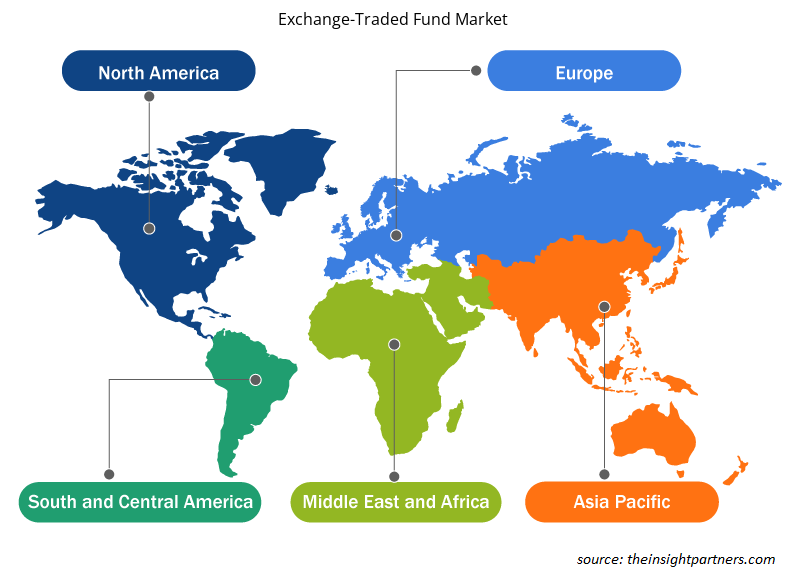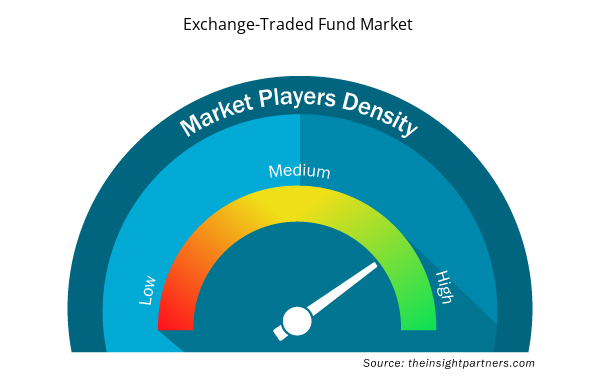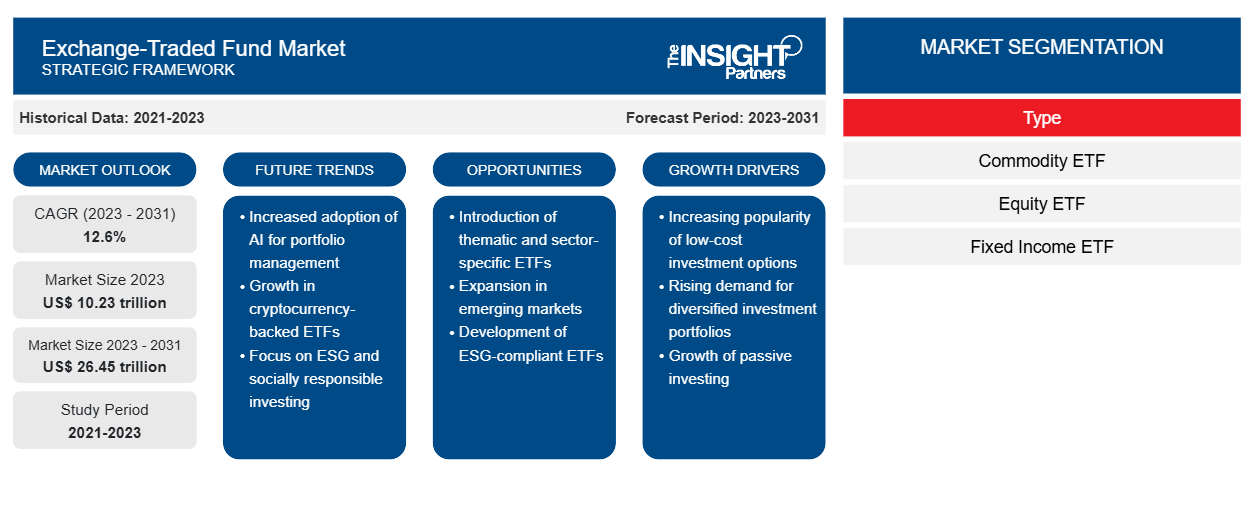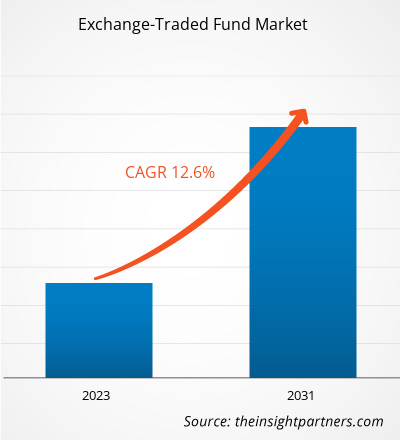Si prevede che le dimensioni del mercato dei fondi negoziati in borsa cresceranno da 10,23 trilioni di $ USA nel 2023 a 26,45 trilioni di $ USA entro il 2031; si prevede che si espanderà a un CAGR del 12,6% dal 2023 al 2031. Si prevede che la crescente popolarità dei fondi negoziati in borsa obbligazionari offrirà elevate opportunità di crescita.
Analisi di mercato dei fondi negoziati in borsa
I fondi negoziati in borsa costituiscono una piccola quota del mercato finanziario globale totale sia nel reddito fisso che nelle azioni, variando dallo 0,4% al 3,0% delle attività a reddito fisso e dal 4 al 15% delle azioni per regione. I vantaggi degli ETF rispetto ai fondi comuni includono costi inferiori, la prospettiva di tracciare la performance dell'intero mercato anziché investire in singole azioni e, in teoria, migliori risultati di investimento, poiché i gestori di fondi attivi tendono a sottoperformare il mercato. Questi vantaggi hanno portato a un'impennata del numero di questi fondi in tutto il mondo, con una crescita sorprendente di circa il 3.000% dal 2003 e guidando la crescita del mercato dei fondi negoziati in borsa.
Personalizza questo report in base alle tue esigenze
Riceverai la personalizzazione gratuita di qualsiasi report, comprese parti di questo report, o analisi a livello nazionale, pacchetto dati Excel, oltre a usufruire di grandi offerte e sconti per start-up e università
- Scopri le principali tendenze di mercato in questo rapporto.Questo campione GRATUITO includerà analisi di dati che spaziano dalle tendenze di mercato alle stime e alle previsioni.
Fondo negoziato in borsa
Panoramica del settore
- Un fondo negoziato in borsa è un tipo di titolo di investimento collettivo che può essere acquistato e venduto in modo molto simile a un'azione individuale. La differenza principale tra un fondo negoziato in borsa e un fondo comune è che, sebbene un fondo comune sia anch'esso un investimento collettivo, viene negoziato solo una volta al giorno dopo la chiusura del mercato.
- Il primo fondo negoziato in borsa è stato l'SPDR S&P 500 ETF (SPY), che replica l'indice S&P 500 ed è ancora oggi un fondo negoziato in borsa molto apprezzato da investitori e trader.
Driver e opportunità del mercato dei fondi negoziati in borsa
Passaggio dai prestiti tradizionali ai fondi negoziati in borsa per guidare il mercato dei fondi negoziati in borsa
- Gli exchange-traded fund sono rinomati per le loro facili opzioni di liquidità. La liquidità è un aspetto indispensabile dell'investimento, che fornisce agli investitori un acquisto e una vendita semplici. Per quanto riguarda gli exchange-traded fund, la liquidità è di notevole importanza.
- La liquidità di un fondo negoziato in borsa si riferisce alla facilità con cui gli investitori possono negoziare o scambiare questi fondi. Questi fondi sono considerati panieri di attività multiforme. Pertanto, maggiore è la liquidità di ogni attività sottostante che comprende un fondo negoziato in borsa, più facile sarà riscattare l'intero fondo negoziato in borsa.
- Gli exchange-traded fund presentano due componenti di liquidità: liquidità delle attività sottostanti e liquidità dell'exchange-traded fund. A causa delle loro complesse procedure di rimborso/creazione, la maggior parte degli exchange-traded fund misura la propria liquidità in riferimento alle attività sottostanti e può includere obbligazioni, azioni, oro, ecc.
Fondo negoziato in borsa
Analisi della segmentazione del rapporto di mercato
- In base alla tipologia, il mercato dei fondi negoziati in borsa è segmentato in ETF sulle materie prime, ETF azionari, ETF a reddito fisso, ETF immobiliari e altri.
- Si prevede che il segmento ETF azionario deterrà una quota di mercato sostanziale degli exchange-traded fund nel 2023. Si tratta di semplici prodotti di investimento che uniscono l'elasticità dell'investimento azionario e la semplicità dei fondi comuni azionari. Gli exchange-traded fund vengono negoziati sul mercato azionario cash, come qualsiasi altro titolo, e possono essere acquistati e venduti ininterrottamente ai prezzi di mercato. Si tratta di strumenti di investimento passivi, basati su indici e investono in titoli nello stesso rapporto dell'indice originale. Grazie alla sua caratteristica di rispecchiamento dell'indice, vi è piena trasparenza sulle partecipazioni di un exchange-traded fund. Inoltre, grazie alla sua struttura distintiva e al meccanismo di creazione, gli exchange-traded fund hanno coefficienti di spesa molto più bassi rispetto ai fondi comuni. Si prevede che tali vantaggi stimoleranno la crescita del mercato degli exchange-traded fund.
Fondo negoziato in borsa
Analisi della quota di mercato per area geografica
L'ambito del rapporto di mercato sui fondi negoziati in borsa è principalmente suddiviso in cinque regioni: Nord America, Europa, Asia Pacifico, Medio Oriente e Africa e Sud America. L'Asia Pacifico (APAC) sta vivendo una rapida crescita, ma si prevede che il Nord America detiene la quota di mercato dei fondi negoziati in borsa più grande. Il significativo sviluppo economico dell'APAC e il crescente interesse per il trading hanno presentato notevoli opportunità di espansione per i fondi negoziati in borsa.
Fondo negoziato in borsa
Approfondimenti regionali sul mercato dei fondi negoziati in borsa
Le tendenze regionali e i fattori che influenzano il mercato dei fondi negoziati in borsa durante il periodo di previsione sono stati ampiamente spiegati dagli analisti di Insight Partners. Questa sezione discute anche i segmenti e la geografia del mercato dei fondi negoziati in borsa in Nord America, Europa, Asia Pacifico, Medio Oriente e Africa, e America centrale e meridionale.

- Ottieni i dati specifici regionali per il mercato dei fondi negoziati in borsa
Ambito del rapporto di mercato sui fondi negoziati in borsa
| Attributo del report | Dettagli |
|---|---|
| Dimensioni del mercato nel 2023 | 10,23 trilioni di dollari USA |
| Dimensioni del mercato entro il 2031 | 26,45 trilioni di dollari USA |
| CAGR globale (2023-2031) | 12,6% |
| Dati storici | 2021-2023 |
| Periodo di previsione | 2023-2031 |
| Segmenti coperti | Per tipo
|
| Regioni e Paesi coperti | America del Nord
|
| Leader di mercato e profili aziendali chiave |
|
Densità degli operatori del mercato dei fondi negoziati in borsa: comprendere il suo impatto sulle dinamiche aziendali
Il mercato dei fondi negoziati in borsa sta crescendo rapidamente, spinto dalla crescente domanda degli utenti finali dovuta a fattori quali l'evoluzione delle preferenze dei consumatori, i progressi tecnologici e una maggiore consapevolezza dei vantaggi del prodotto. Con l'aumento della domanda, le aziende stanno ampliando le loro offerte, innovando per soddisfare le esigenze dei consumatori e capitalizzando sulle tendenze emergenti, il che alimenta ulteriormente la crescita del mercato.
La densità degli operatori di mercato si riferisce alla distribuzione di aziende o società che operano in un particolare mercato o settore. Indica quanti concorrenti (operatori di mercato) sono presenti in un dato spazio di mercato in relazione alle sue dimensioni o al valore di mercato totale.
Le principali società che operano nel mercato dei fondi negoziati in borsa sono:
- Gruppo Allianz
- Società BlackRock Inc.
- Società BNY Mellon
- Fidelity Investimenti Inc
- Società di consulenza Goldman Sachs
Disclaimer : le aziende elencate sopra non sono classificate secondo un ordine particolare.

- Ottieni una panoramica dei principali attori del mercato dei fondi negoziati in borsa
"Analisi del mercato dei fondi negoziati in borsa"è stato condotto in base al tipo e alla geografia. In termini di tipo, il mercato è segmentato in ETF sulle materie prime, ETF azionari, ETF a reddito fisso, ETF immobiliari e altri. In base alla geografia, il mercato è segmentato in Nord America, Europa, Asia Pacifico, Medio Oriente e Africa e Sud America.
Fondo negoziato in borsa
Notizie di mercato e sviluppi recenti
Le aziende adottano strategie inorganiche e organiche come fusioni e acquisizioni nel mercato dei fondi negoziati in borsa. Di seguito sono elencati alcuni recenti sviluppi chiave del mercato:
- A marzo 2024, il gestore patrimoniale VanEck ha annunciato la rinuncia alla sua commissione di sponsorizzazione per il VanEck Bitcoin Trust (HODL), che fornisce esposizione al bitcoin spot, con effetto immediato. Questa modifica dimostra l'impegno di VanEck nel fornire un valore aggiunto agli investitori, anche attraverso prezzi competitivi. Durante il periodo che inizia il 12 marzo 2024 e termina il 31 marzo 2025, l'intera commissione di sponsorizzazione sarà rinunciata per i primi 1,5 miliardi di dollari USA di asset del Trust. Se gli asset del Trust superano 1,5 miliardi di dollari USA prima del 31 marzo 2025, la commissione sugli asset superiori a 1,5 miliardi di dollari USA sarà dello 0,20%. Tutti gli investitori sosterranno la stessa commissione di sponsorizzazione, che è la media ponderata di tali aliquote di commissione. Dopo il 31 marzo 2025, la commissione di sponsorizzazione sarà dello 0,20%.
[Fonte: VanEck, sito web aziendale]
- A marzo 2024, il gestore di asset digitali Grayscale Investments ha presentato domanda per uno spin-off del suo fondo negoziato in borsa spot bitcoin, il Grayscale Bitcoin Trust (GBTC). Lo spin-off fa parte di un'offerta per offrire agli investitori un'esposizione a commissioni più basse al bitcoin. Grayscale ha presentato domanda per quotare le azioni di un nuovo prodotto di investimento, il Grayscale Bitcoin Mini Trust, che riceverà una certa quantità di bitcoin detenuta da GBTC. In cambio, gli attuali azionisti di GBTC otterranno azioni del Mini Trust.
[Fonte: Grayscale, sito web aziendale]
Fondo negoziato in borsa
Copertura e risultati del rapporto di mercato
Il rapporto di mercato su "Dimensioni e previsioni del mercato dei fondi negoziati in borsa (2021-2031)", fornisce un'analisi dettagliata del mercato che copre le seguenti aree:
- Dimensioni e previsioni del mercato a livello globale, regionale e nazionale per tutti i principali segmenti di mercato interessati dall'indagine.
- Dinamiche di mercato quali fattori trainanti, limitazioni e opportunità chiave.
- Principali tendenze future.
- Analisi PEST e SWOT dettagliate
- Analisi del mercato globale e regionale che copre le principali tendenze del mercato, gli attori chiave, le normative e i recenti sviluppi del mercato.
- Analisi del panorama industriale e della concorrenza che comprende concentrazione del mercato, analisi della mappa di calore, attori chiave, sviluppi recenti.
- Profili aziendali dettagliati.
- Historical Analysis (2 Years), Base Year, Forecast (7 Years) with CAGR
- PEST and SWOT Analysis
- Market Size Value / Volume - Global, Regional, Country
- Industry and Competitive Landscape
- Excel Dataset

Report Coverage
Revenue forecast, Company Analysis, Industry landscape, Growth factors, and Trends

Segment Covered
This text is related
to segments covered.

Regional Scope
North America, Europe, Asia Pacific, Middle East & Africa, South & Central America

Country Scope
This text is related
to country scope.
Frequently Asked Questions
The key players holding majority shares in the market are BlackRock Inc, Fidelity Investments Inc, Goldman Sachs, JPMorgan Chase and Co, and The Vanguard Group.
The market is expected to reach US$ 26.45 trillion by 2030.
The global market was estimated to be US$ 10.23 trillion in 2023 and is expected to grow at a CAGR of 12.6 % during the forecast period 2023 - 2031.
The growth of bond exchange-traded funds is anticipated to play a significant role in the global market in the coming years.
Rising demand for easily liquifiable fund options for choosing varied assets for fund allocation are the major factors that propel the market.
Trends and growth analysis reports related to Banking, Financial Services, and Insurance : READ MORE..
- Allianz Group
- BlackRock Inc
- BNY Mellon Corporation
- Fidelity Investments Inc
- Goldman Sachs
- JPMorgan Chase and Co
- Mirae Asset Securities Co Ltd
- Morgan Stanley
- The Vanguard Group
- UBS Group
The Insight Partners performs research in 4 major stages: Data Collection & Secondary Research, Primary Research, Data Analysis and Data Triangulation & Final Review.
- Data Collection and Secondary Research:
As a market research and consulting firm operating from a decade, we have published and advised several client across the globe. First step for any study will start with an assessment of currently available data and insights from existing reports. Further, historical and current market information is collected from Investor Presentations, Annual Reports, SEC Filings, etc., and other information related to company’s performance and market positioning are gathered from Paid Databases (Factiva, Hoovers, and Reuters) and various other publications available in public domain.
Several associations trade associates, technical forums, institutes, societies and organization are accessed to gain technical as well as market related insights through their publications such as research papers, blogs and press releases related to the studies are referred to get cues about the market. Further, white papers, journals, magazines, and other news articles published in last 3 years are scrutinized and analyzed to understand the current market trends.
- Primary Research:
The primarily interview analysis comprise of data obtained from industry participants interview and answers to survey questions gathered by in-house primary team.
For primary research, interviews are conducted with industry experts/CEOs/Marketing Managers/VPs/Subject Matter Experts from both demand and supply side to get a 360-degree view of the market. The primary team conducts several interviews based on the complexity of the markets to understand the various market trends and dynamics which makes research more credible and precise.
A typical research interview fulfils the following functions:
- Provides first-hand information on the market size, market trends, growth trends, competitive landscape, and outlook
- Validates and strengthens in-house secondary research findings
- Develops the analysis team’s expertise and market understanding
Primary research involves email interactions and telephone interviews for each market, category, segment, and sub-segment across geographies. The participants who typically take part in such a process include, but are not limited to:
- Industry participants: VPs, business development managers, market intelligence managers and national sales managers
- Outside experts: Valuation experts, research analysts and key opinion leaders specializing in the electronics and semiconductor industry.
Below is the breakup of our primary respondents by company, designation, and region:

Once we receive the confirmation from primary research sources or primary respondents, we finalize the base year market estimation and forecast the data as per the macroeconomic and microeconomic factors assessed during data collection.
- Data Analysis:
Once data is validated through both secondary as well as primary respondents, we finalize the market estimations by hypothesis formulation and factor analysis at regional and country level.
- Macro-Economic Factor Analysis:
We analyse macroeconomic indicators such the gross domestic product (GDP), increase in the demand for goods and services across industries, technological advancement, regional economic growth, governmental policies, the influence of COVID-19, PEST analysis, and other aspects. This analysis aids in setting benchmarks for various nations/regions and approximating market splits. Additionally, the general trend of the aforementioned components aid in determining the market's development possibilities.
- Country Level Data:
Various factors that are especially aligned to the country are taken into account to determine the market size for a certain area and country, including the presence of vendors, such as headquarters and offices, the country's GDP, demand patterns, and industry growth. To comprehend the market dynamics for the nation, a number of growth variables, inhibitors, application areas, and current market trends are researched. The aforementioned elements aid in determining the country's overall market's growth potential.
- Company Profile:
The “Table of Contents” is formulated by listing and analyzing more than 25 - 30 companies operating in the market ecosystem across geographies. However, we profile only 10 companies as a standard practice in our syndicate reports. These 10 companies comprise leading, emerging, and regional players. Nonetheless, our analysis is not restricted to the 10 listed companies, we also analyze other companies present in the market to develop a holistic view and understand the prevailing trends. The “Company Profiles” section in the report covers key facts, business description, products & services, financial information, SWOT analysis, and key developments. The financial information presented is extracted from the annual reports and official documents of the publicly listed companies. Upon collecting the information for the sections of respective companies, we verify them via various primary sources and then compile the data in respective company profiles. The company level information helps us in deriving the base number as well as in forecasting the market size.
- Developing Base Number:
Aggregation of sales statistics (2020-2022) and macro-economic factor, and other secondary and primary research insights are utilized to arrive at base number and related market shares for 2022. The data gaps are identified in this step and relevant market data is analyzed, collected from paid primary interviews or databases. On finalizing the base year market size, forecasts are developed on the basis of macro-economic, industry and market growth factors and company level analysis.
- Data Triangulation and Final Review:
The market findings and base year market size calculations are validated from supply as well as demand side. Demand side validations are based on macro-economic factor analysis and benchmarks for respective regions and countries. In case of supply side validations, revenues of major companies are estimated (in case not available) based on industry benchmark, approximate number of employees, product portfolio, and primary interviews revenues are gathered. Further revenue from target product/service segment is assessed to avoid overshooting of market statistics. In case of heavy deviations between supply and demand side values, all thes steps are repeated to achieve synchronization.
We follow an iterative model, wherein we share our research findings with Subject Matter Experts (SME’s) and Key Opinion Leaders (KOLs) until consensus view of the market is not formulated – this model negates any drastic deviation in the opinions of experts. Only validated and universally acceptable research findings are quoted in our reports.
We have important check points that we use to validate our research findings – which we call – data triangulation, where we validate the information, we generate from secondary sources with primary interviews and then we re-validate with our internal data bases and Subject matter experts. This comprehensive model enables us to deliver high quality, reliable data in shortest possible time.




 Get Free Sample For
Get Free Sample For